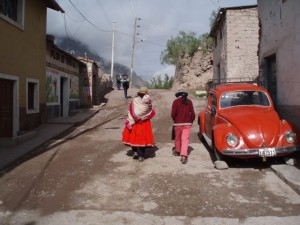
The Streets of Cotahuasi
You know how some people, just to be nice, will say, “You should come visit me sometime.” Well, you should never tell me that unless you are serious, especially if you live somewhere cool, like Peru.
When I was hiking the PCT I met a fellow hiker who was a missionary in the remote Cotahuasi Canyon of Peru. He mistakenly invited me to come visit him, and as soon as I saved up money and time off from work, I was on an airplane to South America.
I flew from DC, and my roundtrip airline ticket was less than $400. If you want a cheap international adventure than head to Central or South America – my international ticket was super affordable and flying domestically within Peru never cost more than $50. Overall, I’ve learned that traveling is so much more affordable when you spend every night in a tent.
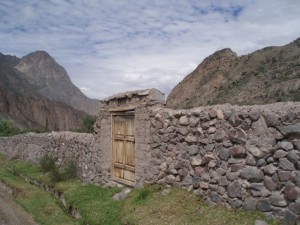
A Rock Wall in the Canyon
From Lima, I flew to Arequipa in the southwest corner of Peru, and there, I was met by my friend Vic. Vic took me by car on a nine-hour expedition to Cotahuasi Canyon. We only passed through one small town along the way, the site of a prehistoric fossil discovery. Prehistoric fit the mood, as it felt like we were traveling back in time. There nothing but dirt and rock for as far as I could see; very little vegetation and no sign of life along the roadway.
During the car-trip, we took a pit-stop to journey up the slopes of an 18,000 ft mountain. The pass, where we parked the car was located at 15,500 ft, and although we probably didn’t hike above 16,000 ft, I was gasping for air with every step. I don’t know if it was the altitude or the local food I ate for lunch, but before we reached our destination I threw up, twice.
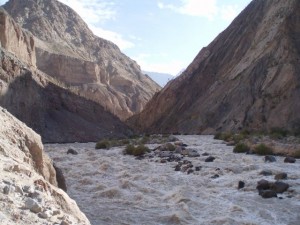
The Rushing Cotahuasi River
When we finally arrived at Cotahuasi it was dark and I was disoriented and quickly went to bed. In the morning it was light and I felt much better. Cotahuasi is the largest town in the canyon, and before we headed out on the trails we stopped to pick up some bread, cheese, and other supplies at the small market. The first thing I noticed about the village was that I was the only white person and English speaker, besides my friend Vic – I loved that. I next noticed the bright colors and multiple pieces of clothing that all the Peruvian woman wore. They looked like a layered rainbow, often with a small child peeping out of one of their colors. There were very few cars in Cotahuasi as most of the travel was still completed by horse or mule, and the buildings were mostly built with mud, stone, brick and straw. In all my travels, I had never been to a place so rural and untouched by modernization. What I didn’t know what that Cotahuasi was a progressive metropolis compared to the other villages we would visit our on tour.
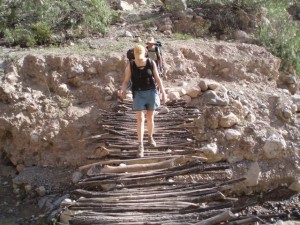
A Very Shaky Bridge
When we were packed and ready, we left town and headed into the canyon. People in Peru say that Cotahuasi Canyon is the deepest canyon in the world. I later heard that this is debatable depending on how you measure the canyon, but when you are next to the roaring Cotahuasi River looking up at the steep, unending canyon walls, it is not hard to believe that the imposing crevasse is the deepest on the planet.
The river itself was swollen and violently crashed against the orange rock of the canyon. Because it was the rainy season the river was full of silt laden run-off, which made it appear brown and dirty. I was extremely nervous when we were forced to cross the expansive river on archaic bridges lined with loose tree branches. I should also mention that the trails we hiked were not modern paths built for tourism, but rather an ancient network of Inca footpaths that served to connect the small canyon villages.
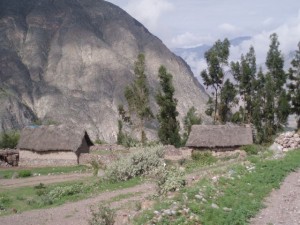
Rural Houses in the Canyon
At the end of our first day we camped by the river and found a nice secluded hot spring in a nearby creek tributary where we could soak our weary bodies. This was the only night we slept in the backcountry; each day thereafter we would camp or spend the night in an indigenous village.
The towns ranged in size from 20-200 people. One town found it’s livelyhood from growing grapes, making wine, and transporting it on mules to nearby villages. Other small towns were almost entirely self-sufficient, living off the potatoes and vegetables that they farmed. One disturbing discovery was that many of the amilies bred guinea pigs, not for pets, but for dinner. I don’t think I ever ate any “cuy” but I did have a few suspicious looking meals.
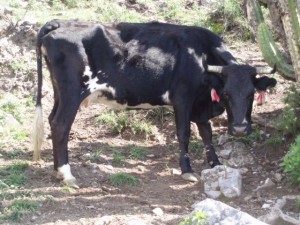
Bull with Pretty Earrings
On our second-to-last day we crossed the high plain above the canyon, which was 16,000 ft above sea level. Unlike our side trip the first day, where I could hardly place one foot in front of the other, by the end of our first week, I easily glided across high terrain.
Although, I heard that they had “pumas,” or mountain lions that lived within the canyon, the animals I saw were mostly domestic, including llamas, mules, alpacas, bulls, and horses. Most of the livestock were allowed to roam free within the canyon, but in their ears they wore a colored ribbon to show who owned them – the Peruvian version of branding.
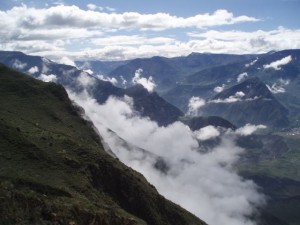
View from the High Plain
At the end of our week together, I was heartbroken to say goodbye to my friend and leave Cotahuasi Canyon, it was the most authentic and breathtaking international adventure I have ever experienced. But the good news was, my friend invited me back! And whether it was a genuine invitation or something he said just to be nice, I am sure that I will see him again.

